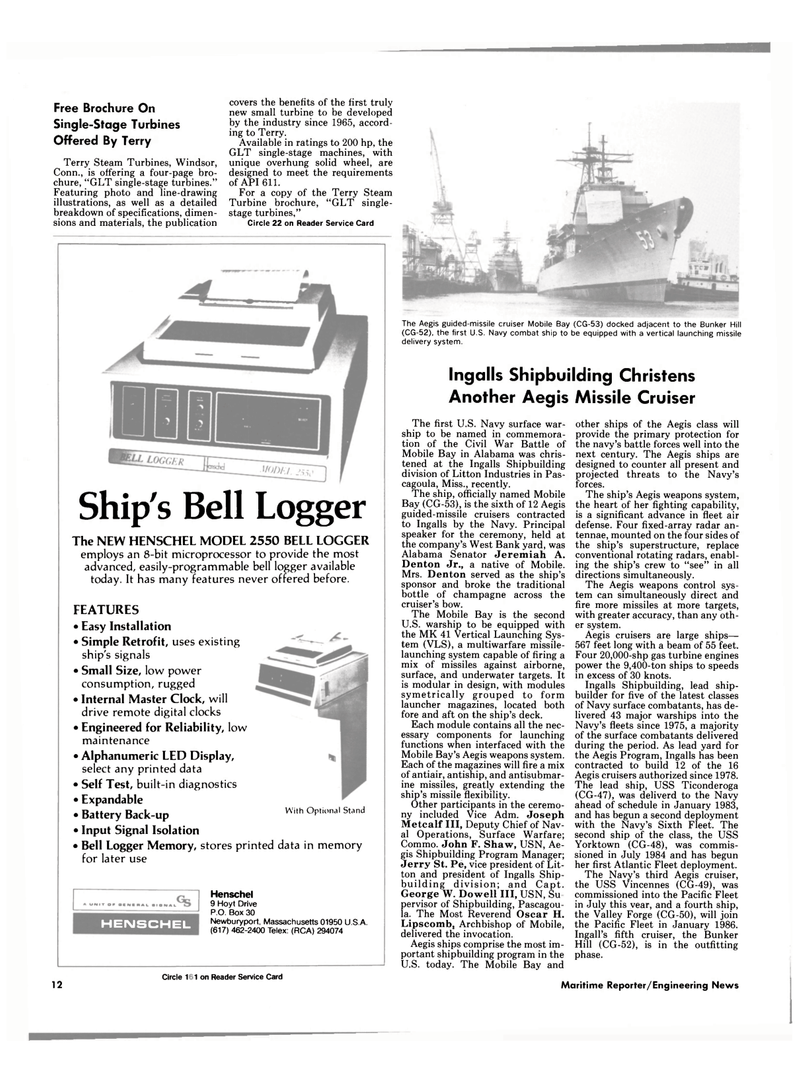
Page 10: of Maritime Reporter Magazine (November 1985)
Read this page in Pdf, Flash or Html5 edition of November 1985 Maritime Reporter Magazine
Free Brochure On
Single-Stage Turbines
Offered By Terry
Terry Steam Turbines, Windsor,
Conn., is offering a four-page bro- chure, "GLT single-stage turbines."
Featuring photo and line-drawing illustrations, as well as a detailed breakdown of specifications, dimen- sions and materials, the publication covers the benefits of the first truly new small turbine to be developed by the industry since 1965, accord- ing to Terry.
Available in ratings to 200 hp, the
GLT single-stage machines, with unique overhung solid wheel, are designed to meet the requirements of API 611.
For a copy of the Terry Steam
Turbine brochure, "GLT single- stage turbines,"
Circle 22 on Reader Service Card
Ship's Bell Logger
The NEW HENSCHEL MODEL 2550 BELL LOGGER employs an 8-bit microprocessor to provide the most advanced, easily-programmable bell logger available today. It has many features never offered before.
FEATURES • Easy Installation • Simple Retrofit, uses existing ship's signals • Small Size, low power consumption, rugged • Internal Master Clock, will drive remote digital clocks • Engineered for Reliability, low maintenance • Alphanumeric LED Display, select any printed data • Self Test, built-in diagnostics • Expandable • Battery Back-up • Input Signal Isolation • Bell Logger Memory, stores printed data in memory for later use
With Optional Stand
HENSCHEL
Henschel 9 Hoyt Drive
P.O. Box 30
Newburyport, Massachusetts 01950 U S A. (617) 462-2400 Telex: (RCA) 294074
The Aegis guided-missile cruiser Mobile Bay (CG-53) docked adjacent to the Bunker Hill (CG-52), the first U.S. Navy combat ship to be equipped with a vertical launching missile delivery system.
Ingalls Shipbuilding Christens
Another Aegis Missile Cruiser
The first U.S. Navy surface war- ship to be named in commemora- tion of the Civil War Battle of
Mobile Bay in Alabama was chris- tened at the Ingalls Shipbuilding division of Litton Industries in Pas- cagoula, Miss., recently.
The ship, officially named Mobile
Bay (CG-53), is the sixth of 12 Aegis guided-missile cruisers contracted to Ingalls by the Navy. Principal speaker for the ceremony, held at the company's West Bank yard, was
Alabama Senator Jeremiah A.
Denton Jr., a native of Mobile.
Mrs. Denton served as the ship's sponsor and broke the traditional bottle of champagne across the cruiser's bow.
The Mobile Bay is the second
U.S. warship to be equipped with the MK 41 Vertical Launching Sys- tem (VLS), a multiwarfare missile- launching system capable of firing a mix of missiles against airborne, surface, and underwater targets. It is modular in design, with modules symetrically grouped to form launcher magazines, located both fore and aft on the ship's deck.
Each module contains all the nec- essary components for launching functions when interfaced with the
Mobile Bay's Aegis weapons system.
Each of the magazines will fire a mix of antiair, antiship, and antisubmar- ine missiles, greatly extending the ship's missile flexibility.
Other participants in the ceremo- ny included Vice Adm. Joseph
Metcalf III, Deputy Chief of Nav- al Operations, Surface Warfare;
Commo. John F. Shaw, USN, Ae- gis Shipbuilding Program Manager;
Jerry St. Pe, vice president of Lit- ton and president of Ingalls Ship- building division; and Capt.
George W. Dowell III, USN, Su pervisor of Shipbuilding, Pascagou- la. The Most Reverend Oscar H.
Lipscomb, Archbishop of Mobile, delivered the invocation.
Aegis ships comprise the most im- portant shipbuilding program in the
U.S. today. The Mobile Bay and other ships of the Aegis class will provide the primary protection for the navy's battle forces well into the next century. The Aegis ships are designed to counter all present and projected threats to the Navy's forces.
The ship's Aegis weapons system, the heart of her fighting capability, is a significant advance in fleet air defense. Four fixed-array radar an- tennae, mounted on the four sides of the ship's superstructure, replace conventional rotating radars, enabl- ing the ship's crew to "see" in all directions simultaneously.
The Aegis weapons control sys- tem can simultaneously direct and fire more missiles at more targets, with greater accuracy, than any oth- er system.
Aegis cruisers are large ships— 567 feet long with a beam of 55 feet.
Four 20,000-shp gas turbine engines power the 9,400-ton ships to speeds in excess of 30 knots.
Ingalls Shipbuilding, lead ship- builder for five of the latest classes of Navy surface combatants, has de- livered 43 major warships into the
Navy's fleets since 1975, a majority of the surface combatants delivered during the period. As lead yard for the Aegis Program, Ingalls has been contracted to build 12 of the 16
Aegis cruisers authorized since 1978.
The lead ship, USS Ticonderoga (CG-47), was deliverd to the Navy ahead of schedule in January 1983, and has begun a second deployment with the Navy's Sixth Fleet. The second ship of the class, the USS
Yorktown (CG-48), was commis- sioned in July 1984 and has begun her first Atlantic Fleet deployment.
The Navy's third Aegis cruiser, the USS Vincennes (CG-49), was commissioned into the Pacific Fleet in July this vear, and a fourth ship, the Valley Forge (CG-50), will join the Pacific Fleet in January 1986.
Ingall's fifth cruiser, the Bunker
Hill (CG-52), is in the outfitting phase. 12
Circle 113 on Reader Service Card
Maritime Reporter/Engineering News

 9
9

 11
11
